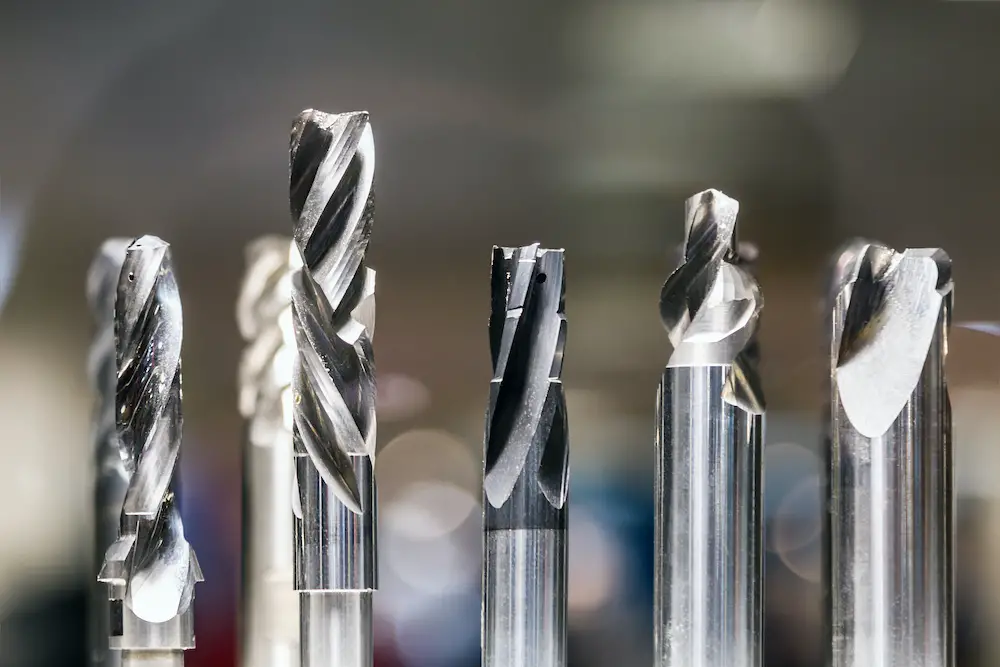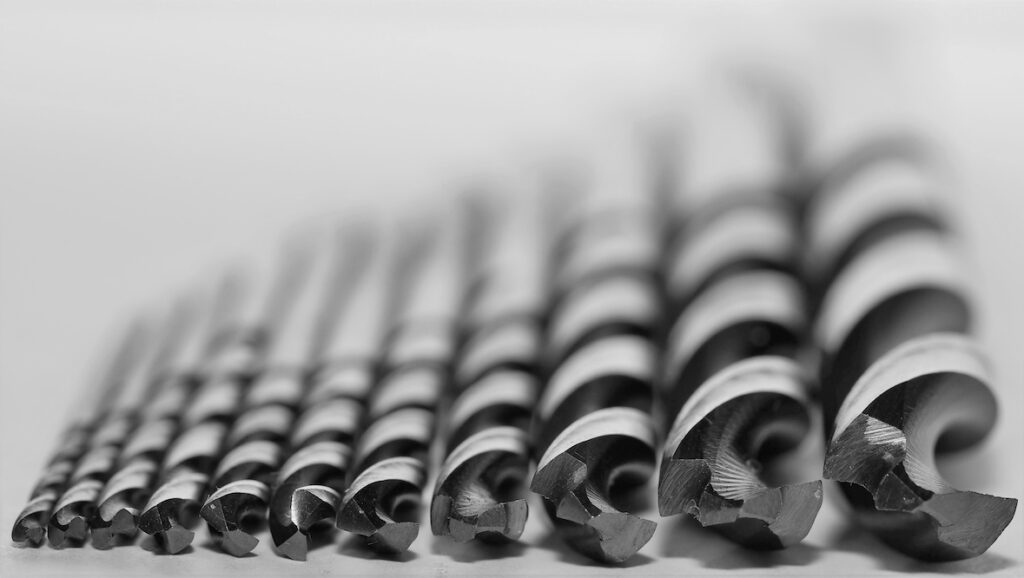Knowing the different types of drill bits on the market can make it easier to tackle an assortment of projects.
It’s easy enough to choose the right drill for your projects, but did you know that it’s also essential to have an assortment of bits since they all have their purposes, advantages, and disadvantages?
Not only do some bits work differently than others, but certain types are also better for specific materials over others.
What Is a Bit for a Drill?
The primary purpose of any drill bit is to help you make a pilot hole or to hollow out a specific spot in your material for an assortment of purposes.
You might want to start a pilot hole for a screw, or perhaps you want to drill out a spot for a dowel to slide through while assembling furniture.
There are plenty of reasons why you will want to get your hands on a bit for a drill, especially if you’re going to be able to use the most popular tool in your kit.
Drill bits come in an assortment of sizes and shapes, not to mention some are for specific materials, such as wood, metal, or glass, and will operate differently than others.
How Do You Identify a Drill Bit?
Identifying a drill bit should be relatively simple, mostly if you’ve held a drill before.
Most drill bits have a twisted design with a pointed tip since these are common to partner up with most materials.
With that said, there are also individual bits that look quite different, such as spade bits that have a flat edge with a pointed tip used for ripping holes through soft materials in a matter of seconds.
The best way to identify a drill bit when you’re in the store is to look at the product name, as it will typically include “bit” or be located close to the drills.
Often, you can find drills that come with a collection of bits in an all-inclusive kit, which should be more than sufficient for everyday household projects.
Otherwise, you’ll want to learn how to identify a drill bit by type, as this can help you to choose the perfect ones for your upcoming project.
What Are the Two Main Types of Drill Bits?
The two most common types of bits that you’re likely to find are twist bits and spade bits.
Twist bits encompass a few different specialty designs, including auger bits, Brad Point bits, and traditional twist designs.
Spade bits, also known as paddle bits, are another popular design that you are likely to see sold with traditional hand drills.
1. Twist Bits
As mentioned, twist bit is a term in describing Brad and auger bits, as they all operate in the same way.
As you insert these bits into a material, such as wood, the spiral groove (flute) carries excess material (chaff) out of the hole so that you have a clear and clean space.
Benefits
One of the main reasons as to why twist bits are as popular as they are is that they are useful for an excessive number of materials and are highly resilient, offering optimal durability over time.
The general purpose design of these units is of high recommendation for DIY enthusiasts and professional contractors alike. This is another reason as to why most drill bit kits come with an assortment of differently sized twist bits.
They differ the most in the materials they could be made from since some materials are stronger and more expensive than others.
Depending on the material you’re working with, you might find individual twist bits to be preferable, for example, cobalt steel bits are better for drilling through metal because they are heat resistant.
Since twist bits are so standard, they are typically the most affordable bit type that you can find. A professional can easily sharpen them if they start to get dull.
Another benefit is that you can find them in any size, which helps to add to their versatility and allows you to make holes of various sizes.
Drawbacks
However, unless you invest in the more expensively made bits, such as carbide tipped or carbon steel, they are very likely to break over time.
Twist bits can also be frustrating for contractors since the flute can quickly fill up with chaff when working with wood, forcing them to spend more time clearing holes.
2. Spade Bits
Spade bits, on the other hand, have a basic design, but it certainly doesn’t take away from their reliability and versatility.
Most often, people who use paddle or spade bits are looking to rip holes through soft materials, such as wood, as quickly as possible.
With these bits, you will want to enter a material to work through the entire slab so that the bit exits at the back, whereas twist bits are more for burrowing into a material.
The main difference you are to experience with these bits is that they require far more torque than twist bits. This means that they are best with higher-powered hand drills.
Benefits
Spade bits have far fewer maintenance costs and upkeep than other bits that you can get your hands on.
Spade bits work well in most hand drills, and they are also an affordable option, similar to twist bits.
You’ll especially love using these models when it comes to working with softwoods, which is where their versatility ends.
Drawbacks
Unfortunately, these designs aren’t ideal for any other type of material, especially since they are likely to leave a ragged hole behind.
Spade bits are also a little less user-friendly because of how quickly they turn, which can cause you to have a tighter grip on the drill than you would with other types.

What Are the Different Types of Drill Bits?
Knowing all of the different types of bits can help make it easier to have the right gear for building boats, renovating a room in your home, or working on an industrial project.
1. Auger Bits
As earlier mentioned, auger bits are typically classified under twist bits, but they could easily be in their category as well.
With a design that is similar to twist bits, auger models have substantially larger flutes that are ideal for removing giant chips and chunks of material out of a hole.
Most often, you’ll find that auger bits are a heavy-duty option that is most useful for wood, similar to space bits, and they will be longer than other types on this list.
One of the most exciting features of these bits is that they have been around for hundreds of years, far before the invention of the hand drill.
Typically, you would operate augers manually, as the user would turn a handle, which would drive the flute into the wood, allowing for the removal of bigger chunks of wood very quickly.
If you’re on the hunt for smoother holes than what you would achieve with a spade bit, an auger is a far better alternative.
Pros:
- Less blowout
- Ideal for deep medium-sized holes
- Comfortable to use manually
- Easily removes chaff
Cons:
- Limited to softwoods
- For small to midsize holes
2. Forstner Bits
Forstner bits are easily classified as some of the most expensive drill bits that you can find, but their performance makes them well worth the cost.
They offer optimal precision and impeccable finishes compared to any other bit, thanks to the pointed center that helps the user to stay on their target.
When you use a Forstner bit, the device will cut in two ways at the same time, rather than one course with simpler designs.
You’ll find there’s an exterior blade that prevents splintering while the surface blades help to shave away the material that pops out as you insert the bit into the material.
When you’ve finished drilling with these bits, you’ll find the holes will be flat at the bottom and have very smooth sides, which makes them the perfect option for woodworking and finishing.
Pros:
- Creates smooth walls
- Provides flat-bottom holes
- Makes holes from 1/4” to three inches
Cons:
- Requires a lot of pressure
- Could need a drill press
- Limited to soft materials
- Highly costly
3. Step Bit
If you were to take a look at the outside of a step bit, you’ll find its surface is quite similar to a set of stairs, which allows you to cut holes of a variety of sizes with a single bit.
The central premise behind its design is, the further the bit travels into the material, the larger the hole will be, thanks to its conical design.
You’ll find there will be a section of the bit with a variety of measurements that show the smallest and largest hole that you can cut.
Step bits are mostly for working with sheet metal, as they allow you to drill precisely without the worry of deforming the metal.
The accuracy and quickness of step bits help to add to their popularity, especially since they make simple smooth-edged holes in thin materials.
With that said, step bits are best for thin materials, which limits their versatility, especially if you need bits designed for woodworking.
You might also find that there are extra steps you’ll have to take with these bits, such as making a pilot hole, since the tip of the bit isn’t as sharp as what you’d receive with a twist bit, for example.
Pros:
- Cuts many sizes
- Creates precise holes
- Ideal for metalwork
Cons:
- Only used with thin materials
- Tough to sharpen
FAQs
1. What Is the Hardest Type of Drill Bit?
There is a wide variety of different materials used to make drill bits, with some being better for hard materials and others more useful for delicate items, such as wood.
By far, the most challenging type of bits will be made from carbide, though there are several alternatives you may want to consider as well.
Carbide
Although carbide is the most rigid drill bit material that you can find, it’s also the most brittle, which is why it is typically used with high-quality equipment that won’t put its integrity at risk.
Most fully carbide bits shouldn’t be used with traditional hand drills since they can cause significant damage to the bit; however, there are carbide-tipped bits that you can use with regular drills.
You’ll find that most contractors will use carbide-tipped bits for tile, masonry, and concrete, as they stay sharper for longer than other materials.
High-Speed Steel (HSS)
If you invest in a drill kit, you’ve likely received bits made from high-speed steel, as it’s an economical solution for bits that you will be using regularly.
You’ll find this material is best suited for wood and metal, which is why it’s one of the most versatile options on the market.
You can also use high-speed steel bits with fiberglass and PVC.
Cobalt (HSCO)
The third most popular type of drill bit material is cobalt, which is a slight upgrade from high-speed steel since cobalt is blended with the base materials, helping to harden the bit.
However, cobalt designs aren’t as hard as carbide, though they can be a more economical option if you’re working with steel and stainless steel.
One of the most considerable advantages to cobalt bits is that they help to dissipate heat and are abrasion-resistant, which allows them to stay sharper for longer.
2. What Angle Should a Drill Bit Be?
It’s easy for beginners to believe that a hole is a hole, but when it comes to more delicate projects, such as boat building, you’ll want to make sure you choose bits that have the perfect angle for beautifully finished holes.
You’ll find the two most common drill bit angles are 118° and 135°, which are ideal for allowing you to take advantage of optimal thrust for the fastest and cleaning cutting possible.
118° bits are best used for dealing with soft materials, such as aluminum and wood, whereas you might be more interested in 135° versions for stainless steel.
Another difference between the two is speed, as 135° bits will work faster, as the surface is flatter, allowing the bit to start the full cutting action much quicker.
The downside is that this can negatively affect the finished look of the hole and could be likely to cause splintering in some materials.
3. What Drill Bits Are Best for Boat Building?
Several bits could be quite beneficial when you begin building a boat, most of which we’ve discussed in this guide.
You will surely want to have an assortment of twist bits, as they are impeccable for removing chaff from wood and allow you to make precise holes of various sizes without investing too much money into your equipment.
Specifically, Brad Point bits can be a great option, as the tip is not only sharp but also shaped like a “W,” allowing it to enter the wood and create a clean exit hole quickly.
It’s also a good idea to have a collection of spade bits, as they are highly recommended for ripping holes through wood quickly, which can then be finished at a later date.
You’ll also like having spade bits at your disposal because they are made explicitly for woodworking and can be quite useful once you tackle their learning curve.
A few other bit types to keep in mind include:
- Forstner Bits: This is a perfect option for creating beautifully finished holes with flat bottoms.
- Countersink Bits: The best choice for making precise pilot holes at the perfect depth and are also specifically designed for wood.
- Plug Cutter: If you’re dealing with countersunk fasteners, a plug cutter drills the perfect wood plug that you can use for concealment.
Types of Drill Bits: Final Thoughts
Whether you intend to build your boat or if you want to tackle household projects, there are many types of bits to choose from.
Knowing what types are best suited for specific projects can help you to make the most out of your time and improve the quality of your finished work.


